Who does David Treat ?
Life's stages, lifestyles and natural changes in the body’s physical properties, can bring a number of different musculoskeletal problems, which can be helped with osteopathic treatment.
Children and adolescents often present with aches and pains related to growth, development or injury. Early assessment and treatment, often involving a gentle massage and stretching of the muscles and soft tissues affected can bring much needed relief and allay concerns.
For adults whose routine is physically demanding, David is expert in dealing with acute sprains of muscles, joints, ligaments and troublesome discs. For those with more sedentary occupations, he deals with low and upper back pain together with neck and shoulder tension. For Repetitive Strain Injuries (RSI) affecting hands wrists and elbows he will alleviate symptoms in affected muscles, tendons and joints, give postural guidance together with ergonomic advice and an exercise routine to prevent future injury.
For older and retired patients the effects of degenerative changes and arthritis may cause problems with pain and stiffness of the affected joints and muscles. David provides gentle treatment to ease muscle pain and keep joints free as possible. David treats patients of all ages, whose muscular tension and pain are related to emotional stress. He helps relieve symptoms and gives advice on remedial relaxation techniques.
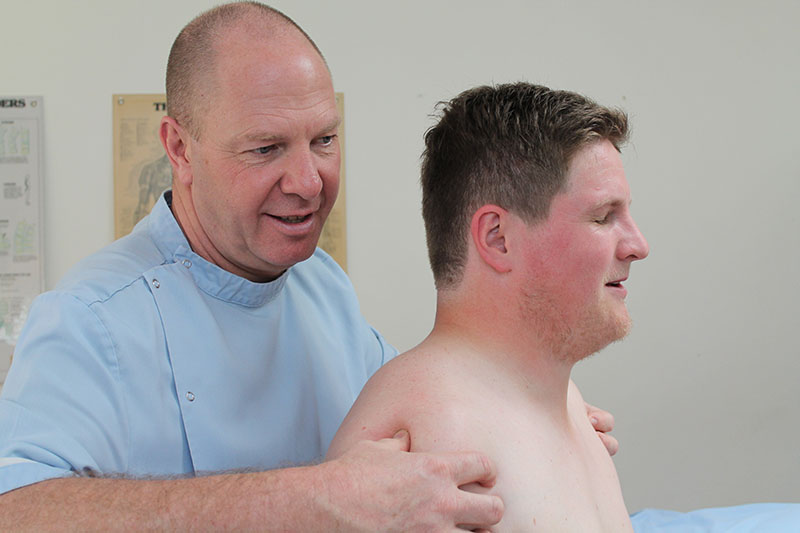
See below for further details of conditions treated ...
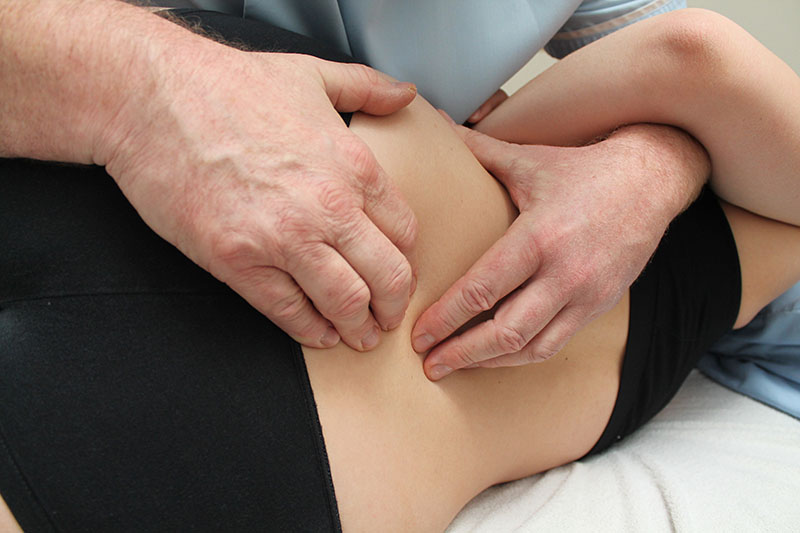
Low Back Pain
Low Back pain Back pain is one of the commonest reasons people see a doctor or osteopath and miss days at work.
Back pain can range in intensity from a dull constant ache to a sudden sharp shooting pain.
There are two types of back pain:
Acute, or short term, lasting a few days to a few weeks. Most low back pain is acute. In some cases a few months are required for the symptoms to resolve.
Chronic back pain, is defined as pain that continues for 12 weeks or even longer, even after an initial injury or underlying cause of acute low back pain has been treated. About 20 per cent of people affected by acute low back pain develop chronic low back pain with persistent symptoms at one year. Even if pain persists, it does not always mean there is a medically serious underlying cause, or that it can be easily identified and treated. In some cases treatment successfully relieves chronic low back pain but in other cases pain continues despite medical and surgical treatment.
It has been shown that early intervention with advice on management of acute pain, including reassurance, pain control, manual therapies such as osteopathy along with exercises can help prevent acute developing into chronic pain!
Most acute low back pain is mechanical in nature sprains, (overstretched muscles or torn ligaments), strains, (bulging discs, tears in tendons or muscles), spasms (sudden contraction of a muscle or group of muscles)
Conditions that can lead to chronic pain include:
Spondylosis, the general degeneration of the spine associated with normal wear and tear that occurs in the joints, discs and bones of the spine as people get older.
Spondylitis, an inflammatory condition affecting the spine.
Spondylolisthesis, which happens when a vertebrae in the lower spine slips forwards out of place, this maybe as a result of degenerative changes in the spine or as a result of vertebral fractures or defects in a younger spine.
Osteoporosis, a progressive decrease in bone density and strength that can lead to painful fractures of the vertebrae.
Skeletal irregularities, such as scoliosis (a curvature of the spine).
By taking a detailed case history, followed by a thorough examination David will be able to provide you with an honest opinion of what factors are contributing to your pain and whether or not osteopathic treatment will be beneficial or not. He will give you guidance on self help strategies and exercises and in cases where he suspects you need further medical investigations such as blood tests, X Rays or MRI scans he will make the appropriate referral.
Stress and anxiety
Most people feel stressed sometimes and some people find stress helpful or even motivating, but if stress is affecting your life, there are things you can try that may help.
Symptoms of stress
Stress can cause many different symptoms. It may affect how you feel physically, mentally and also how you behave.
It's not always easy to recognise when stress is the reason you're feeling or acting differently.
Over the last year, David has noticed a significant increase in the number patients attending his clinic with symptoms related to the stresses associated with changes to their lifestyles during the Covid pandemic.
Physical symptoms of stress
These include:
- Headaches or dizziness
- Muscle tension or pain
- Stomach problems
- Chest pain or a faster heartbeat
Mental symptoms
- Difficulty concentrating
- Struggling to make decisions
- Feeling overwhelmed
- Constantly worrying
- Being forgetful
Changes in behaviour
- Being irritable and snappy
- Sleeping too much or too little
- Eating too much or too litte
- Avoiding certain places or people
- Drinking or smoking more
How can Osteopathy Help?
Osteopathy can help work at alleviating the muscle tension in the areas affected, most commonly in the mid back and neck and for some patients this enables them to relax more.
Just talking through your problems can also be of help and David will guide you on techniques such as relaxation and breathing exercises to help alleviate your symptoms.
Sciatica
Sciatica is where the sciatic nerve, which runs from your lower back to your feet is irritated or compressed.
If you have sciatica you may have symptoms of pain, tingling, (like pins and needles,) numbness and/or weakness in your buttock, back of your thigh, leg, foot and toes.
Your symptoms may be worse when moving, sneezing or coughing.
You may also have back pain, but it’s not usually as bad as the pain in your bottom, leg or foot.
You probably don’t have sciatica if you only have back pain.
Common causes of sciatica include:
A bulging intervertebral disc, often described as a slipped disc, when a soft cushion of tissue between the bones in your spine pushes out.
Spinal Stenosis: narrowing of the part of the spine where your nerves pass through, commonly due to wear and tear in older spines.
Spondylolisthesis: when one of the bones in your spine slips out of position.
More often than not sciatica gets better in 4 to 6 weeks but can sometimes last longer.
As with the assessment of low back pain, after David has taken a thorough case history he will examine your spine. As well as looking at your back he will carry out neurological testing including checking your reflexes, strength of muscles and to see if the compression of the nerves has had any affect on your ability to feel touch and or pain on your skin. He will then advise you on how to manage your recovery and whether or not osteopathic treatment is applicable.
In some cases, when symptoms aren’t resolving or worsening, you may need to be referred for an MRI scan and a neurosurgical opinion. Under such circumstances David will always give you a thorough explanation as to his reasons for doing so.
Similar symptoms can affect the front of your thigh and leg, this may be as a result of irritation of the femoral nerve caused by the same conditions above but affecting areas slightly higher in your low back!
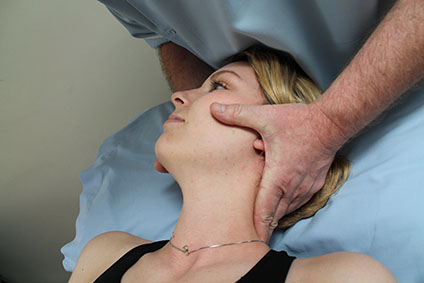
Neck Pain
Neck pain is another very common problem seen by David and most of us will have it at some point in our lives. Usually, neck pain is the result of holding your neck in the same position for too long. However , other things can also cause or contribute to neck pain, such as:
worry or stress
sleeping awkwardly
an accident
a sprain or strain
a flare up of cervical spondylosis, which can happen as the discs and joints in the spine age.
David has seen many cases recently which have been related to more and more of his patients working from home, as a result of the Covid Pandemic. This has led to poor work station set ups and people working longer hours at their computers and laptops, leading to postural stress and tension through the muscles and joints of the neck.
The most common symptoms are of pain in the middle or either side of your neck, but it may also extend to the shoulder or to the upper chest.
You may have pain, pins and needles, numbness and/or weakness in your arms as a result of nerves being trapped where they leave the neck, this is known as a cervical radiculopathy
You may have tension headaches where the pain can travel to the back of your head and sometimes into your ear or behind your eye.
It may be painful to move your neck and your muscles may feel tight, especially if you’ve been sitting or sleeping in one position for a long time.
You may notice that your neck won’t turn as far as it normally does, for example when you try to look over your shoulder while reversing you car.
You may feel clicking or grating noises as you move your head. This is called crepitus and it can be caused by air bubbles popping, or tissues and bones moving over each other in the facet joints. Other joints often do this too, but noises from your neck usually seem louder because they’re happening closer to your ears. You may also find this more noticeable at night. Whilst this is a common symptom and can sound alarming, it’s not serious.
If you feel dizzy when looking up or turning your head, this may be due to pinching of the arteries that run alongside the spine, otherwise known as vertebral arteries. This can sometimes happen as a result of changes in the vertebrae.
Muscle spasms are the sudden stiffening up of a muscle or groups of muscles in your body. Often caused by sudden movement or stress through the neck, or sleeping in an awkward position causing a “wry neck”, sometimes there is no known cause. Such spasms can be very unpleasant. When they occur it usually causes pain and stiffness down one side, which can make it difficult to turn your head.
It usually only lasts a few hours or days for such spams to ease, although rarely they may continue for several weeks. In many cases Osteopathic treatment has been found to help speed up recovery from such bouts of pain and give some relief for longer term neck pain.

Shoulder Pain
The shoulder is a complex joint, the most mobile peripheral joint we have and pain in and around it can be due to a multitude of conditions.
These include:
- Rotator cuff sprains and tears
- Capsulitis or “frozen shoulder”
- Arthritis
- Impingement syndrome
- Biceps tendonitis
- Bursitis
- Polymyalgia rheumatic
- Acromioclavicular joint pain
- Instability
Shoulder pain may also be coming from the neck and such pain may be associated with pins and needles or numbness, in your arm and/or hand, this is known as cervical radiculopathy.
The diagnosis of shoulder pain depends on David taking a thorough medical history as well as that of the presenting condition.
Questions will be asked such as, where is the location of your pain, how long has it persisted, was there a trauma moment that brought it on or has it developed gradually, what movements aggravate it and is it painful to lie on and/or disturbing your sleep.
A thorough examination of the shoulder is then required, observing for any swelling or displacement, palpating (feeling) for any tender areas and then observing all the ranges of movement to see what restrictions there are and which ones cause pain. He will also check to see if any pain is triggered by resisted movements, and if there is any weakness, which may be indicative of muscle sprains or tears.
There are also a multitude of specific orthopaedic tests which can help determine the diagnosis and David will perform these where appropriate.
Once the examination is complete David will discuss his findings and provisional diagnosis with you and then the options as regards treatment, as well as guiding you on a rehabilitation program, which will more often than not involve some form of exercises.
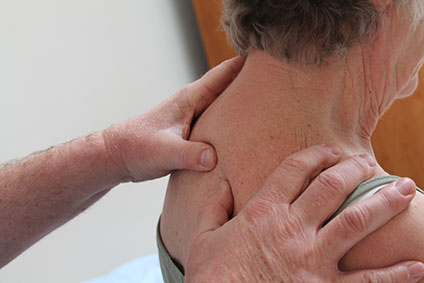
Tension-type headaches
A tension-type headache is the most common type of headache and the one we think of as a normal everyday headache.
Symptoms of tension-type headaches
It may feel like a constant ache that affects both sides of the head. You may also feel the neck muscles tighten and a feeling of pressure behind the eyes. A tension headache normally is not severe enough to prevent you doing everyday activities. It usually lasts for 30 minutes to several hours, but can last for several days.
Who gets tension-type headaches?
They can develop at any age, but are more common in teenagers and adults. Women tend to have them more than men.
Some adults have tension-type headaches more than 15 times a month for at least 3 months in a row.
This is known as having chronic tension-type headaches.
What causes tension-type headaches?
The exact cause of tension-type headaches is not clear, but certain things have been known to trigger them.
These include
- Stress and anxiety
- Squinting
- Poor posture
- Tiredness
- Dehydration
- Missing meals
- Lack of physical activity
- Bright light
- Noise
- Certain smells
Tension-type headaches are not life threatening and are usually relieved by painkillers or lifestyle changes.
Osteopathy and tension-type headaches.
David has treated many people over the years for such headaches using a combination of massage techniques to ease muscular tension in the neck, shoulders and upper back as well as loosening up stiffer joints in these areas with gentle manipulation.
This combined with advice on exercises and posture as well as providing and relaxation techniques often helps.alleviate the symptoms.
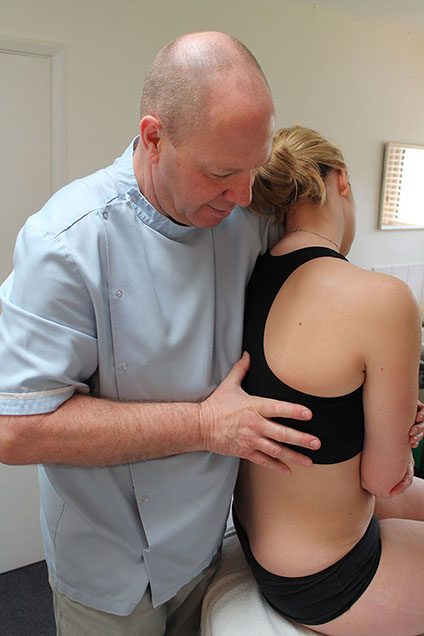
Mechanical Mid-Back (Thoracic) and Rib Pain
Thoracic pain is back pain that occurs in the “thoracic spine”, which is located at the back of the chest (the thorax), mostly between the shoulder blades.
The thoracic area is designed for stability, to anchor the rib cage and to provide protection for vital organs within the chest.
The thoracic spine tends to be resistant to pain and injury. When pain in this area does occur it is often due to prolonged postural stresses or injury causing the muscles or joints around this area to over work and become painful.
Musculoskeletal causes of thoracic pain
Pain in the thoracic area may well have an obvious cause, for example cutting a hedge or doing some lifting or gardening. You may have “strained” a muscle playing sport, in other cases the pain may come on for no apparent reason.
Prolonged postures, for example sitting at a PC or laptop for hours without a break may lead to pain and generally the best advice is not to be in any one position too long as the spine likes to be regularly moved.
Thoracic pain may also be associated with stress, worry or feeling low. Adults with thoracic pain commonly have aches and pains elsewhere in their body.
People who sit for long periods, (more than seven hours per day), or those who are less active (less than 150 minutes per week) tend to have more stiffness and pain in the thoracic spine.
Trauma to the thoracic spine can cause pain which can commonly take some weeks or months to resolve. Movement and normal activity is very important to enable the body to heal.
Other causes of thoracic pain include the following:
- Osteoporotic fractures (where vertebrae, weakened by osteoporosis collapse)
- Infection of the spine
- Osteoarthritis
- Disc Prolapse or herniation
- Shingles
- Scheurmann’s disease (increased spinal curvature in adolescents but not always painful)
- Ankylosing spondylitis
- Problems from the stomach, pancreas, oesophagus and gall bladder can also cause pain in the thoracic spine, in such cases the nature of te pain is different yo that of musculoskeletal pain and health professional are trained to spot the differences.
Rib cage pain
Rib cage pain can vary in sensation and location due to several possible causes.
The ribs are attached at the back to the thoracic spine by the costovertebral joints and at the front, to the sternum (breast bone) by the sternocostal joints. Trauma or sprains of these joints ant the muscle around them can lead to pain around the ribs. Likewise so can pulled or inflamed muscles between the ribs (the intercostal muscles).
Costochondritis is a common cause of rib cage pain and occurs when the cartilage connecting your ribs to your sternum is inflamed causing:
- Pain when breathing deeply, or coughing or sneezing
- General discomfort in your ribs
- Pains and aching around your sternum area
Costochondritis isn’t a cause for concern as it is often due to minor injury or sprain and will heal itself in time. Persistent pain should always be followed up with a doctor.
As well as musculo-skeletal pain rib cage pain may be due to underlying heart disease or conditions affecting the lungs such as pleurisy, pneumonia and in rare cases lung cancer.
The symptoms of a heart attack include:
- Chest pain towards the middle and left side of your chest
- Difficulty breathing
- Pain throughout your jaw, arms and shoulders
- Nausea and dizziness
If you think you are having a heart attack you should call 999 immediately!!
David will take into consideration the history and nature of your symptoms and after questioning you about your general health and completing a thorough clinical evaluation will advise you as to whether he can help alleviate your pain or if you need referral for further investigations.
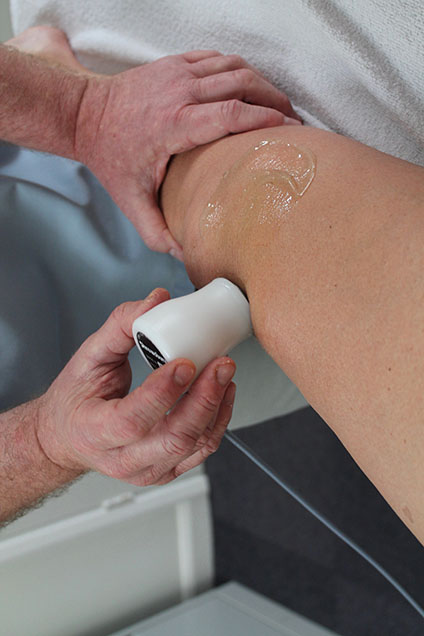
Sports Injuries
The benefits of sports far outweigh the risks, but occasionally injuries do happen.
What causes sports injuries
Sports injuries can be caused by:
- an accident – such as a fall
- not warming up properly before exercising
- using inappropriate equipment or poor technique
- pushing yourself too hard
Almost any part of your body can be injured, including the muscles, bones, joints and connective tissues (tendons and ligaments). The ankles and knees are particularly prone to injury (see the other sections on this website).
What to do if you have an injury
If you’ve injured yourself, you may have immediate pain, tenderness, swelling and bruising and restricted movement or stiffness in the affected area. Sometimes these symptomsmay only be noticeable several hours after exercising or playing sports.
Stop exercising if you feel pain, regardless of whether your injury happened suddenly or you’ve had the pain for a while. Continuing to exercise whilst injured may cause further damage and slow your recovery.
Treating a sports injury
You can usually treat common minor injuries yourself by:
- resting the affected part of the body for the first 48 to 72 hours to prevent further damage
- regularly applying ice to the affected area during the first 48 to 72 hours to reduce swelling. The ice should be wrapped in a damp cloth/towel and applied for a maximum of 20 minutes each time.
- You can use paracetamol to help with the pain, David advises against the use of anti-inflammatory medication, such as ibuprofen, in the initial 48-72 hours as inflammation is part of the body’s healing mechanism and should not be suppressed in this phase of healing!
Minor injuries should improve within a few days or weeks but if they aren’t then David will be able to give you advice on how to help your recovery and where appropriate treatment for example ultrasound and massage to promote healing, as well as giving you guidance on rehabilitation exercises.
If he feels you require further investigations he will refer you appropriately.
Preventing Sports Injuries
You can reduce your risk of getting injured by:
- Warming up properly before exercise
- Not pushing your body beyond your current fitness level
- Using the right equipment – for example, wearing running shoes for running, shin guards for football and a gum shield for rugby
- Receiving coaching to learn correct techniques
When starting a new sport or activity, get advice and training from a qualified fitness trainer or sports coach.
If you contact David he will always discuss what has happened to you over the phone and then advise you if he feels he will be able to help or if you need to see another healthcare professional.
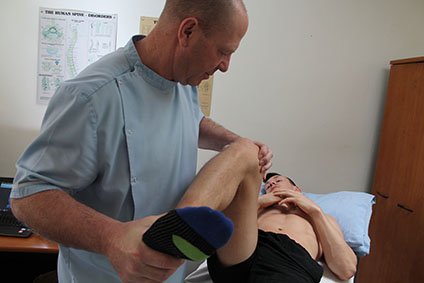
Hip Pain
Hip pain is a common complaint that can be caused by a wide variety of problems. The precise location of your hip pain can provide valuable clues about the underlying causes.
Problems within the hip joint itself tend to result in pain on the inside of your hip and groin. Hip pain on the outside of your hip, upper thigh or outer buttocks usually caused by problems with muscles, ligaments, tendons and other soft tissues that surround your hip joint.
Causes of pain in and around the hip include:
- Arthritis
- Trochanteric bursitis
- Gluteal tendinopathy
- Labral tears
- Acetabular impingement
- Hip dysplasia
Knee Pain
Knee pain is a common complaint among adults and most often associated with general wear and tear from daily activities like walking, bending, standing and lifting. Athletes who run or play sports that involve jumping or quick pivoting are also more likely to experience knee pain and problems. But whether an individual’s knee pain is caused by aging or injury, it can be a nuisance and in some circumstances debilitating.
Common knee conditions David sees include:
- Ligament sprains or tears
- Torn cartilages (menisci)
- Arthritis
- Muscle sprains
- Tendonitis
- Patello-femoral pain
Foot and ankle pain
Most people experience pain in and around their feet and ankles at some point in their lives. It is one of the most complex, hard-working regions of your body. It has 26 bones and 33 small joints , all held together by a network of soft tissue made up of muscles, tendons, ligaments nerves and blood vessels.
Most cases of foot or ankle pain are short term and are caused by soft tissue injuries, such as sprains or strains. These should gradually heal with the help of simple measures, although some could take a few months to fully recover.
Other conditions can develop over time as a result of altered biomechanics and structural changes in this complex structure, for example as the result of fallen arches.
Common conditions affecting the foot and ankle include:
- Ligament sprains or strains
- Achilles tendinopathy
- Plantar fasciitis
- Tibialis posterior dysfunction
- Metatarsalgia
- Morton’s neuroma
- Gout
- Osteoarthritis
David’s history taking and examination will enable him to give you a provisional diagnosis on what is causing the pain in your hip, knee ankle or foot and he will then give you advice as to whether further investigations such as X rays, blood tests or scans are required to help or confirm that diagnosis. He will give an honest appraisal of what he feels he can do to help with treatment and/or exercise advice or whether you need to be referred on for an Orthopaedic opinion.
David works alongside Derry Locke at Southmead Clinic. Derry is an extremely experienced Podiatrist/Chiropodist working in the NHS, but also sees patients privately at Southmead.
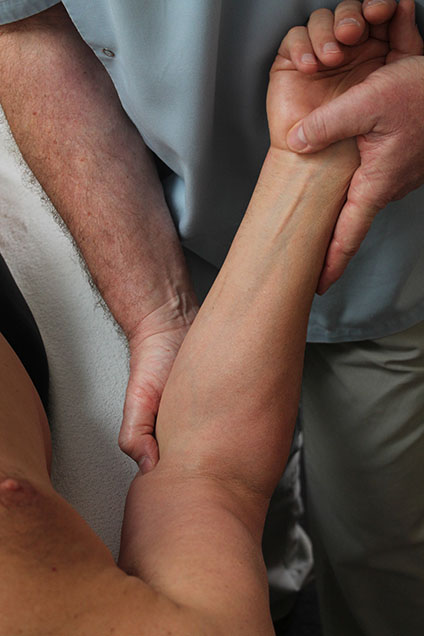
Elbow, wrist and hand pain
Tennis elbow
The commonest condition David sees affecting the elbow is tennis elbow. It is a condition that causes pain on the outside of the elbow.
It's clinically known as lateral epicondylitis. It often happens after overuse or repeated action of the muscles of the forearm, near the elbow joint.
You may notice pain on the outside of the elbow, which may travel down the forearm when:
- Lifting or bending your arm
- When gripping small objects, such as a pen
- When twisting your forearm, such as turning a door handle or opening a jar
What causes tennis elbow?
Tennis elbow is usually caused by overusing the muscles attached to your elbow and used to straighten your wrist. If the muscles are strained, tiny tears and inflammation can develop near the bony bump (the lateral epicondyle) on the outside of your elbow.
As the name suggests, tennis elbow is sometimes caused by playing tennis, but any activity that puts repeated stress on the elbow joint can cause it, for example using a screw driver, saw, secateurs or hammer or repetitive computer mouse use.
Golfer's elbow is the same, but rarer condition but affecting the inner side of your elbow, known as medial epicondylitis.
Most people who get tennis elbow are between the ages of 30 and 50, although anyone can get tennis elbow if they have risk factors. In racquet sports like tennis improper stroke technique and improper equipment may be risk factors.
Tennis elbow can occur without any recognised repetitive injury. This occurrence is called ''idiopathic'' or of unknown cause.
What should I do to help my symptoms?
You should avoid the activity that is causing the pain until your symptoms improve.
Holding a cold compress such as a bag of frozen peas wrapped in a towel, against your elbow for up to 15 minutes, several times per day can help ease the pain. Taking pain killers., such as paracetamol may help reduce mild pain. Non-steroidal anti inflammatory drugs (NSAID's), such as ibuprofen, can also be used to help reduce inflammation. If the pain does not go away after a few days of rest then it is wise to seek further advice.
David will check for swelling and tenderness and carry out simple tests, such as flexing your wrist while your elbow is stretched out, checking your grip and seeing if certain resisted movements cause you pain.
Treatment from David that may help alleviate the pain includes massaging and manipulating the affected area, which also help improve the range of movement in your arm. He will also give you appropriate exercises to do. He may also use ultrasound to help promote healing.
If the treatment and exercises he provides to not work he may suggest referral for a steroid injection.
Surgery may be used as a last resort, if there is severe and persistent pain, to remove the damaged part of the tendon.
Tennis elbow can last between 6 months to 2 years, but a full recovery is made within a year in 9 out of 10 cases.
Wrist and hand pain
Wrist pain is often caused by sprains or fractures from sudden injuries, but it can also result from long-term problems, such as repetitive stress, arthritis and carpal tunnel syndrome.
Because so many factors diagnosing the exact cause can be difficult, but an accurate diagnosis is essential for proper treatment and healing.
Symptoms
Wrist and hand pain may vary, depending on the cause. For example osteoarthritis pain is often described as being similar to a dull toothache, whilst carpal tunnel syndrome usually causes a pins and needles feeling or tingling sens tion, into your fingers especially at night. The precise location of your wrist pain also provides clues to what's behind your symptoms.
Not all wrist pain requires medical care. Minor sprains and strains usually respond to ice, rest and over the counter pain medication, but if pain and swelling last longer than a few days or become worse then seek a consultation.
Causes
Sudden impacts. Wrist injuries often occur when you fall forward onto your outstretched hand. This can cause sprains, strains and even fractures. A scaphoid fracture involves a bone on the thumb side of the wrist. This type of fracture may not show up on X-rays immediately after the injury.
Repetitive stress. Any activity that involves repetitive wrist motion - from hitting a tennis ball or bowing a cello to driving long distances - can inflame the tissues and tendons around joints or cause stress fractures. De Quervain's disease is a repetitive stress injury that causes pain at the base of the thumb.
Osteoarthritis and Rheumatoid arthritis
Carpal tunnel syndrome. Carpal tunnel syndrome develops when there's increased pressure on the median nerve as it passes through the carpal tunnel, a passage way in the palm of your wrist. Pregnancy, diabetes, obesity, rheumatoid arthritis and gout may increase your risk of developing carpal tunnel syndrome.
Ganglions cysts. These soft tissue cysts occur most often on the part of your wrist opposite your palm.
Kienbock's disease. This disorder typically affects young adults and involves the progressive collapse of one of the small bones of the wrist. Kienbock's disease occurs when the blood supply to the bone is compromised.
Risk factors for wrist and hand pain
Wrist pain can happen to anyone, whether you're very sedentary, very active or somewhere inbetween. But your risk may be increased by:
- Sports participation
- Repetitive work
- Certain diseases (as outlined above with regard to carpal tunnel syndrome)
If you have concerns about wrist and hand pain then contact David, he will discuss the problem with you over the phone and decide whether or not its is worthwhile for you to come and see him for a full evaluation of the problem and the advise you on management and/or treatment.
Repetitive strain injury (RSI)
Repetitive strain injury (RSI) is a general term used to describe the pain felt in muscles, nerve and tendons caused by repetitive movement and overuse.
It’s also known as work-related upper limb disorder, or non-specific upper limb pain.
The condition mostly affects parts of the upper body, such as the:
- Forearms and elbows
- Wrists and hands
- Neck and shoulders
Symptoms of RSI
The symptoms of RSI can range from mild to severe and usually develop gradually. They often include:
- Pain, aching or tenderness
- Stiffness
- Throbbing
- Tingling or numbness
- Weakness
- Cramp
At first, you might only notice symptoms when carrying out a particular repetitive action.
However without treatment, the symptoms of RSI may eventually become constant and cause longer periods of pain. You may also get swelling in the affected area, which can last for several months.
What to do if you think you have RSI
If you develop symptoms of RSI and think it may be related to your job, speak to your employer or occupational health representative.
It may be possible to modify your tasks to improve your symptoms.
What causes RSI
RSI is related to the overuses of muscles and tendons in the upper body.
Certain things are thought to increase the risk of RSI, including:
- Repetitive activities
- Doing a high intensity activity for a long time without rest
- Poor posture
Cold temperatures and vibrating equipment are also thought to increase the risk of getting RSI and can make symptoms worse. Stress can also be a contributing factor.
Jobs that involve repetitive movements can lead to RSI, such as working on an assembly line, at a supermarket checkout or on a computer.
Tour work environment should be as comfortable as possible. You should ideally have a workplace assessment so that any adjustments needed can be made.
Your employer has a legal duty to try to prevent work-related RSI and ensure anyone who already the condition doesn’t get worse.
How is RSI treated
The first step in treating RSI is usually to identify and modify the task or activity that is causing the symptoms. If necessary you may need to stop the activity altogether.
To relieve symptoms you may be recommended to take paracetamol or an anti-inflammatory such as ibuprofen. It may also be suggested that you use a hot or cols pack, elastic support or splint.
David can advise on posture, ergonomic work place set ups and exercises to help strengthen or relax your muscles as well as offer osteopathic treatment to relieve your symptoms.
How to prevent RSI
Most employers carry out a risk assessment when you join a company to check that your work area is suitable and comfortable for you. You can request an assessment if you haven’t had one.
There are things you can do to help reduce your risk of getting RSI, such as:
- Maintaining good posture at work
- Taking regular breaks from long or repetitive tasks-it’s better to take smaller frequent breaks than one long lunch break.
- Trying breathing exercises if you’re stressed`
If you work at a computer all day, make sure your seat, keyboard, mouse and screen are all positioned so they cause the least amount of strain.
See tips on preventing RSI (Link: www.nhs.uk/live-well/healthy-body/tips-to-prevent-rsi/) for more detailed advice about using a mouse and keyboard at work.
Arthritic Pain
Osteoarthritis and rheumatoid arthritis are the 2 most common types of arthritis.
Osteoarthritis
Osteoarthritis is the most common type of arthritis in the UK, affecting nearly 9 million people.
It most often develops in people in their mid-40's or older.
It is also more common in women and people with a family history of the condition. •
But it can occur at any age as a result of an injury or be associated with other joint-related conditions, such as gout or rheumatoid arthritis.
Osteoarthritis initially affects the smooth cartilage lining of the joint. This makes movement more difficult than usual, leading to pain and stiffness.
Once the cartilage lining starts to roughen and thin out, the tendons and ligaments have to work harder.
This can cause swelling and the formation of bony spurs called osteophytes.
Severe loss of cartilage can lead to bone rubbing on bone, altering the shape of the joint and forcing the bones out of their normal position.
The most commonly affected joints are those in the:
- Hands
- Spine
- Knees
- Hips
Rheumatoid arthritis
In the UK, rheumatoid arthritis affects more than 400,000 people.
It often starts when a person is between 40 and 50 years old. Women are 3 times more likely to be affected than men.
In rheumatoid arthritis, the body's immune system targets affected joints, which leads to pain and swelling.
The outer covering (synovium) of the joint is the first place affected.
This can then spread across the joint, leading to further swelling and a change in the joints shape. This may cause the bone and cartilage to break down.
People with rheumatoid arthritis can also develop problems with other tissues and organs in their body.
Other types of arthritis related conditions
Ankylosing spondylitis - a longterm inflammatory condition that mainly affects the bones, muscles and ligaments of the spine, leading to stiffness and joints fusing together. Other problems can include the swelling of tendons, eyes and large joints.
- Cervical spondylosis - also known as degenerative osteoarthritis, cervical spondylosis affects the joints and bones in the neck, which can lead to pain and stiffness
- Fibromyalgia - causes pain in the body's muscles, ligaments and tendons
- Lupus - an autoimmune condition that can affect many different organs and the body's tissues
- Gout - a type of arthritis caused by too much uric acid in the body. This can be left in
the joints (usually affecting the big toe), but can develop in any joint. It causes intense pain, redness and swelling
- Psoriatic arthritis - an inflammatory joint condition that can affect people with
psor1•as1•s
- Enteropathic arthritis- a form of chronic inflammatory arthritis associated with inflammatory bowel disease, the 2 main types being ulcerative colitis and Crohn's disease. About 1 in 5 people with Crohn's disease or ulcerative colitis will develop enteropathic arthritis. The most common areas affected by inflammation are the peripheral (limb) joints and the spine.
- Reactive arthritis - this can cause inflammation of the joints, eyes and the tube that
urine passes through (urethra). It develops shortly after an infection of the bowel, genital tract or less frequently, after a throat infection
- Secondary arthritis - a type of arthritis that can develop after a joint injury and
sometimes many years afterwards
- Polymyalgia rheumatica - a condition that almost always affects people over 50 years of age, where the immune system causes muscle pain and stiffness, usually across the shoulders and tops of the legs.
Symptoms of arthritis
The symptoms you experience will vary depending on the type you have: This is why it's important to have an accurate diagnosis if you have:
- Joint pain, tenderness and stiffness
- Inflammation in and around the joints
- Restricted movement of the joints
- Warm red skin over the affected joint
- Weakness and muscle wasting
Treating arthritis
There's no cure for arthritis andtreatments include lifestyle changes, exercise, medicines and surgery.
In certain cases Osteopathic treatment including massage to the soft tissues around the affected joints and gentle mobilisation of the joints may help give some relief from the pain,
this is not always the case and is dependent on the condition you present with, for example gout would not be helped by such treatment.
David will take a thorough case history of your symptoms and advise you as to whether he feels he can help you or if you need referral for further investigations such as blood tests and X-rays or if you need to consult your GP or a Rheumatologist.
